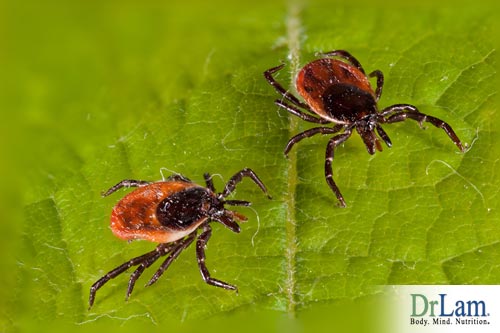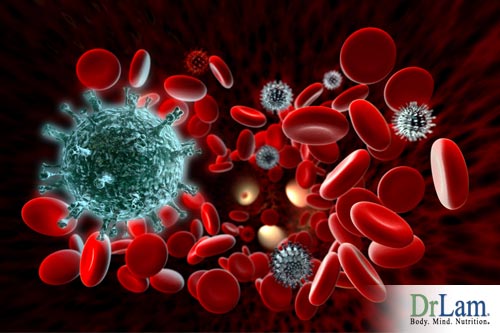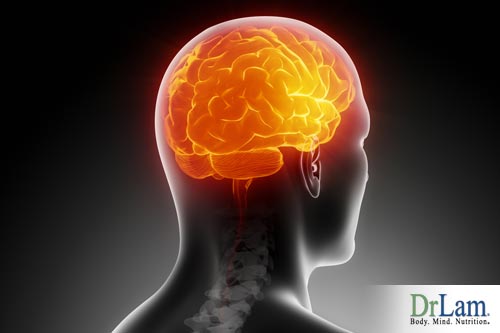
 Lyme disease, also known as Lyme Borreliosis, is an illness caused by an infection of one or more species of the Borrelia genus of bacteria, including B. burgdorferi, B. barinii, and B. afzelli. There are over 50 discovered species, and more are being revealed with time. Of these species, 13 are known to cause Lyme disease.
Lyme disease, also known as Lyme Borreliosis, is an illness caused by an infection of one or more species of the Borrelia genus of bacteria, including B. burgdorferi, B. barinii, and B. afzelli. There are over 50 discovered species, and more are being revealed with time. Of these species, 13 are known to cause Lyme disease.
Borrelia colonize the gut microbiome of the Ixodes scapularis tick, often early in its life cycle when the tick feeds on a mouse or rat. These small rodents, therefore, act as carriers of the Borrelia bacteria, more often than not along with other co-infectious organisms and pathogens such as viruses and parasites.
Borrelia belongs to a class of pathogens known as spirochete (similar to the syphilis pathogen). Borrelia bacteria are shaped like a spiral corkscrew and have the ability to drill through our body’s defense barriers into deep cravens that are hard to reach with antibiotics. In addition, they can penetrate through the cell wall and live intracellularly, using the healthy cell wall as a shield. Therefore, Borrelia can survive the harshest of internal environments or the onslaught of antibiotics with ease. Once inside the body, Borrelia and its various co-infectious agents collectively form a battalion of smart, persistent pathogens that can render the body defenseless.
Other common carriers of the Borrelia pathogen include field mice, deer, and raccoons. Dogs are common carriers as well. It is estimated that up to 16% of dogs in Vermont would test positive for Borrelia. Dogs pick up ticks throughout the year when walking through grassy, wooded, or sandy areas, and adult ticks are not killed by frost. The tick can jump from dogs to humans, carrying infectious pathogens with it. Thus, humans can become infected while strolling through grassy areas or playing with their dogs. When an infected tick feeds on a human host, Borrelia and its many co-infectious agents may be passed on, infecting the host. Because ticks are frequently encountered in backyards and outdoor recreational areas, the spread of Lyme disease is much more common than suspected.
This is made worse by the fact that in many cases the host does not even feels the tick bite, and therefore, does not recall ever being bitten. This means that acute Lyme disease could be missed, and eventual chronic Lyme disease symptoms may come as a surprise.
Even though tick bites are the most common method of transmission and infection by the Borrelia bacteria responsible for causing Lyme disease, cases of tick-borne diseases tracing back to blood transfusions have been reported.
Lyme disease is endemic in most continents in the Northern Hemisphere, with cases reported in Africa, Asia, Europe (especially Central Europe), and the Americas (especially the Northeastern part). Reported in almost every country worldwide except Antarctica, Lyme disease is the top vector-borne disease in the USA and Europe. In Africa, rodents infiltrate rural homes without proper sanitization and act as a major source of Lyme disease. Its prevalence is second only to malaria. In general, different strains of Borrelia bacteria are predominate in or constrained to certain geographical regions. Whereas the most prevalent strain in North America is B. Burgdorferi, in Europe and Asia, B. Afzelii and B. Garinii are more endemic. There is, however, a great deal of crossover between the three main strains.
With global warming and cross-border animal migration, the problem of Lyme Disease is worsening and no longer restricted by physical barriers. Nobody is immune.
Borrelia infections have three stages: early localized, early disseminated, and late disseminated. For most people infected with Lyme disease, the first sign is usually a bullseye-shaped skin lesion or rash that appears at the bite site between a few days and up to four weeks after being bitten. The rash will vary in shape and form between individuals and is, in fact, absent in 20 to 30 percent of those infected. Other early symptoms can include headaches, muscle soreness, fever, fatigue, and flu-like symptoms. Acute Lyme disease is therefore often missed. If unrecognized and untreated, the infection can grow beyond the initial stages and spread throughout the body.
A clinical study carried out at Yale University found that in a cohort of 314 Lyme disease patients, half began to develop secondary skin lesions and rashes at sites far removed from the original bite. These were accompanied by further symptoms, including migratory musculoskeletal pain, swelling of the lymph nodes, swelling of the testes, and irritation of the meninges of the brain. The bacteria can also attack the nervous system, causing memory loss, sleep problems, brain fog, facial palsy, and can affect the circulatory system, leading to arrhythmia of the heart.
 Although it has been around for a long time—the first description of the classic skin rash was over a century ago—Lyme disease was only recognized in the United States in the 1970s. Diagnosis of Lyme disease is not easy or clear cut and continues to be complicated by a lack of reliable and definitive tests. The lack of specificity and sensitivity in serum testing is a major reason why Lyme disease often goes undetected. Though good strides are being made, progress is slow. Current laboratory tests are only about 50% accurate. Blood tests often fail to detect the antibodies in the early stages of infection before Lyme disease has had the chance to really take hold. This is because it can typically take the body anywhere between four to six weeks for the immune system to generate enough antibodies/immunoglobulin to fight the Borrelia infection, as shown in standard testing.
Although it has been around for a long time—the first description of the classic skin rash was over a century ago—Lyme disease was only recognized in the United States in the 1970s. Diagnosis of Lyme disease is not easy or clear cut and continues to be complicated by a lack of reliable and definitive tests. The lack of specificity and sensitivity in serum testing is a major reason why Lyme disease often goes undetected. Though good strides are being made, progress is slow. Current laboratory tests are only about 50% accurate. Blood tests often fail to detect the antibodies in the early stages of infection before Lyme disease has had the chance to really take hold. This is because it can typically take the body anywhere between four to six weeks for the immune system to generate enough antibodies/immunoglobulin to fight the Borrelia infection, as shown in standard testing.
Normal standard laboratory diagnosis of Lyme disease includes a 2-tiered serologic test comprised of an enzyme-linked immunoassay (EIA or ELISA) or immunofluorescence assay, followed by Western Blot tests. Sadly, both the ELISA and Western Blot are indirect tests, meaning they only measure an antibody response to infection, and not the infection itself. Also, as with any laboratory test, false positives do occur, especially if there is a history of Epstein-Barr virus or some other previous infection.
The CDC requires 5 out of 10 IgG bands for a positive test result. However, since some bands on a Western Blot are more significant than others, your doctor may decide you have Lyme disease even if your Western Blot does not have the correct number of bands, or specific bands, recommended by the CDC.
Tests that can be helpful in assisting the clinical diagnosis of Lyme Disease include:
After a bite, if the tick can be caught and retained, it can be tested for the Borrelia bacteria. However, this is still inconclusive, because a bite does not always transmit the pathogen, and the tick that was tested may not have been the vector for the pathogen. In addition, tick testing takes a significant amount of time, potentially allowing the Lyme disease infection to grow.
Instead of relying on laboratory tests alone, a diagnosis must, therefore, be based on the combination of medical history, history of potential tick exposure, and correlation of symptoms, along with any available laboratory test results. Lyme disease is therefore based on a clinical diagnosis, much like Chronic Fatigue (affecting about 3.5 % of the US population) and Fibromyalgia (affecting about 1.5% of the US population), rather than a laboratory diagnosis.
The biggest challenge to correct diagnosis and timely treatment of Lyme disease is that many people may not remember being bitten by a tick, and these individuals do not develop a skin rash upon infection, therefore, detection and treatment may not occur on time or be totally missed only to be discovered in retrospect months or years later.
The conventional treatment for early stage Lyme disease consists of a 2- to 3-week course of oral antibiotics, followed by a repeat course, as required. Successful clinical outcomes are evidenced by reduced symptoms and laboratory immunoglobulin titers that have returned to normal. At this point, most patients are pronounced cured, treatment ceases, and the tick is presumed to be eradicated. Traditionally, any negative clinical symptoms experienced after the antibiotic course or treatment is presumed to be unrelated to the Borrelia pathogen.
Unfortunately, this classic positive outcome is not universal. In fact, many patients remain unwell after standard antibiotic treatment. They are told that any persistent symptoms are no longer Lyme related. Many are abandoned by their treating physician and thereafter, told to see a psychiatrist or some other specialist for non-Lyme related illnesses. Some are told they have post-treatment Lyme disease syndrome (PTLDS), but no solution is offered.
 Continued and lingering symptoms include migrating joint pain, ongoing memory issues, brain fog, tingling sensations, insomnia, exercise intolerance, heart palpitations, postural orthostatic tachycardia syndrome (POTS)-like symptoms, and chronic fatigue. These symptoms gradually worsen over time even though laboratory titers continue to remain normal or only slightly abnormal. The term “chronic Lyme disease”, based on the clinical observation of continued presence of symptoms, has not gained much traction within the conventional medical community. Despite the fact that many patients clearly continue to suffer after antibiotic treatment.
Continued and lingering symptoms include migrating joint pain, ongoing memory issues, brain fog, tingling sensations, insomnia, exercise intolerance, heart palpitations, postural orthostatic tachycardia syndrome (POTS)-like symptoms, and chronic fatigue. These symptoms gradually worsen over time even though laboratory titers continue to remain normal or only slightly abnormal. The term “chronic Lyme disease”, based on the clinical observation of continued presence of symptoms, has not gained much traction within the conventional medical community. Despite the fact that many patients clearly continue to suffer after antibiotic treatment.
Lyme Disease is a great imitator of other conditions. As such, many patients have been misdiagnosed with Alzheimer’s Disease, usually when Borrelia attack the brain cells and generates amyloid plaques. Some are told they have multiple sclerosis or even amyotrophic lateral sclerosis since most clinicians are unaware that Borrelia can affect the neuronal sheath, thus, producing similar symptoms. Other frequently encountered misdiagnoses include psychosis, depression, chronic fatigue, fibromyalgia, and auto-immune diseases (Lupus or Hashimoto’s thyroiditis). These errors are made more prevalent with the support positive laboratory tests. Multiple specialists are often sought as one failure follows another. The team of experts commonly includes an endocrinologist, rheumatologist, neurologist, psychiatrist, and infectious disease consultant, to name a few. It is not unusual for a Lyme disease patient to see more than 10 doctors and be taking more than 20 prescription medications, such as sleeping pills, anti-depressants, pain meds, gastric reflux medications, and anti-anxiety agents.
 Unfortunately, once chronic Lyme disease settles in the body, the natural progression is one of slow but steady decline with, at best, intermittent period of apparent wellness. Over a period of months to years, repeated relapses and flare-ups of chronic Lyme disease can render the sufferer bedridden and housebound. Many are unable to maintain a job. Most chronic Lyme sufferers are therefore in a state of frustration and do not know where to turn as one therapy after another fails to bring satisfactory long-term recovery. Many are also financially exhausted with nowhere to turn to. Relapses tend to occur, resembling a roller coaster ride with a cascading downward trend. The more the body is emotionally or physically stressed, the greater the speed of decline, and the intensity and frequency of relapses. The body is in an overall state of decompensation, clinically known as chronic Lyme disease.
Unfortunately, once chronic Lyme disease settles in the body, the natural progression is one of slow but steady decline with, at best, intermittent period of apparent wellness. Over a period of months to years, repeated relapses and flare-ups of chronic Lyme disease can render the sufferer bedridden and housebound. Many are unable to maintain a job. Most chronic Lyme sufferers are therefore in a state of frustration and do not know where to turn as one therapy after another fails to bring satisfactory long-term recovery. Many are also financially exhausted with nowhere to turn to. Relapses tend to occur, resembling a roller coaster ride with a cascading downward trend. The more the body is emotionally or physically stressed, the greater the speed of decline, and the intensity and frequency of relapses. The body is in an overall state of decompensation, clinically known as chronic Lyme disease.
Lyme disease is a truly multi-systemic disease, meaning the course of infection affects multiple different systems. Crucially, the nervous system—brain and spinal cord—is one of the systems most often affected if the pathogen is given the opportunity to spread throughout the body.
One of the symptoms of Lyme infection in the brain is cerebral edema or swelling of the brain. As the brain swells, it begins to push on the meninges—surrounding membrane—and can even begin to squeeze against the interior of the skull. Neurological chronic Lyme disease symptoms include:
These conditions can have a cognitive toll as well. The brain’s ability to process information and think straight is negatively affected. It’s like finding out that there’s LSD in the punch and you’re not sure what’s going to happen next or if you’re going to be in control of your own thoughts. In fact, 70 percent of people dealing with Lyme disease also report changes in their thinking such as memory loss and reduced mental sharpness.
 This fact is backed by neurologists from the American Academy of Neurology, who say patients with nervous system Lyme disease may also have one or more of the following symptoms:
This fact is backed by neurologists from the American Academy of Neurology, who say patients with nervous system Lyme disease may also have one or more of the following symptoms:
Other specific symptoms of cognitive decline include:
Not all Lyme-infected individuals will experience all the symptoms, even after a significant period of time. Many may find they mainly notice headaches, neuralgias, brain fog, and cognitive slowness. Notably, many chronic Lyme disease symptoms mimic other conditions.
 Evidence pointing to a connection between neurological infection of Borrelia bacteria and psychiatric manifestations of Lyme disease continues to mount. Many psychiatric chronic Lyme disease symptoms are related to inflammation and swelling of brain tissue as it reacts to the Borrelia infection. This has a marked effect on cognition and mental function. In fact, psychiatric Lyme disease has been linked to virtually every psychiatric diagnosis and can affect people of all ages from all walks of life.
Evidence pointing to a connection between neurological infection of Borrelia bacteria and psychiatric manifestations of Lyme disease continues to mount. Many psychiatric chronic Lyme disease symptoms are related to inflammation and swelling of brain tissue as it reacts to the Borrelia infection. This has a marked effect on cognition and mental function. In fact, psychiatric Lyme disease has been linked to virtually every psychiatric diagnosis and can affect people of all ages from all walks of life.
In one case study, a college student developed panic attacks and severe anxiety along with loss of appetite and insomnia. These were eventually traced back to Lyme disease and seemed successfully treated. However, the student later began to experience a recurrence of earlier symptoms accompanied by additional auditory hallucinations, obsessive thoughts, and bouts of déjà vu.
These ongoing psychiatric symptoms may herald further and more severe mental and cognitive disruptions. A number of studies found connections between neurological Borrelia infections and learning disabilities, mood swings, depression, personality changes, suicidal tendencies, and tendencies toward increased aggression and violence. For example, studies have shown that psychiatric in-patients are nearly twice as likely as the average population to test positive for Lyme disease. The National Institutes of Health have sponsored a major study of neuropsychiatric Lyme disease in an effort to determine specific changes to the brain.
Unfettered, Lyme disease has nearly free reign to saddle sufferers with many debilitating symptoms. In so many cases, however, the Lyme disease connection is often missed. Neurological, psychiatric, and physical symptoms can mimic various other illnesses and conditions throughout the various stages of infection, including Epstein-Barr, lupus, or even Adrenal Fatigue, thereby presenting a major challenge to correct diagnosis. As a result, many infected people have never actually been diagnosed with Lyme disease and instead suffer from neurological or psychiatric symptoms without knowing the actual cause.
The mechanism behind the chronic form of Lyme disease is the fact that infectious pathogens exist stealthily in a what is known as a subclinical (asymptomatic) infectious state. Once antibiotics have been used to kill off active pathogens, symptoms of acute Lyme disease have been suppressed, and the toxic load has diminished, a small number of Borrelia bacteria continue to hide and live persistently inside host cells. The cell wall acts as a pathogen shield, and while inside the cell, the pathogen rests calmly awaiting its next opportunity to exit the cell wall and enter the extracellular matrix (ECM) where it can be transported to target organs to cause destruction. When transported to the brain and central nervous system, symptoms of nerve paralysis can occur.
Migration from within the cell to the ECM often happens after stopping antibiotics or when the host body is weak due to poor diet, or emotional or physical stress. That is, a body under emotional stress with weak adrenal glands provides the perfect environment for stealth infections to resurface. In addition, pathogens are protected within the cell by the cell wall and moreover, can secrete a biofilm to protect themselves outside the cell, making them partially impenetrable by regular antibiotics, unless they are particularly strong. This dual self-defense mechanism renders the host helpless to these pathogens.
That is why repeated courses of standard antibiotics often fail. Unless the antibiotics have an intracellular focus and are delivered on a rotational basis—pulsed intermittently to catch the Borrelia and other co-infections whilst unguarded in advanced cases of Lyme disease—simply repeating a course of antibiotics is usually ineffective and can do more damage to the host than the pathogen. Therefore, it should come as no surprise that a body which has gone through multiple courses of antibiotics is weakened over time.
Other intracellular pathogens that behave similarly to Lyme disease include H. pylori, Epstein-Barr, and candida. These pathogens are also impossible to eradicate in full once they have chronically infected the body. Any aggressive attempt could in fact cause more collateral damage to the body, making the overall clinical outlook worse over time.
Remember that stealth infections co-inhabit inside out bodies as part of their survival mechanism. In the stealthy subclinical infectious state, the organisms are in a near-dormant low activity state. Laboratory tests appear “normal”, and patients are therefore told that all is well. In reality, the host is still infected, though the infection maintains a low profile subclinical infectious state. Small-scale immunological responses and low-grade inflammation responses can be triggered by pathogens under these conditions. Occasional mild resurfacing of symptoms is bothersome but not debilitating. No large-scale general immunologic response from the body’s defense system, such as acute inflammation and massive leukocyte production, is triggered. Physicians are therefore fooled into believing their mission of eliminating Borrelia and its co-infections is complete. It is very important to know that even in their stealth state, these pathogens do continue to secrete minute amounts of toxic metabolites and byproducts as a function of their own metabolism, causing chronic symptoms such as migrating joint pain, fatigue, tingling, and other chronic Lyme disease symptoms. The wax and wane nature of symptoms simply reflects the degree of activities of the pathogen during its habitation within the host.
In healthy bodies, these toxins, including the neurotoxins that attack the central and peripheral nervous system causing headaches and joint pain, are low enough in quantity that normal detoxification and internal cleansing systems keep them from doing much harm. The liver detoxification process is fully activated, clearing the excessive toxic metabolites of stealth pathogens. Moreover, the adrenal glands are placed on overdrive, producing cortisol as an anti-inflammatory agent. Laboratory tests are normal and the entire NeuroEndoMetabolic (NEM) stress response system is on active duty, often running on overtime. A healthy liver, immune system, adrenal glands, microbiome, ECM, and kidneys all contribute to flushing out the toxins of stealth infections, removing them via the ECM to the liver, and ultimately, through the kidneys, lungs, skin, and GI track for excretion.
However, in cases where the normal internal stress control system is weakened (largely modulated by the adrenal glands), detoxification functions become overwhelmed (mostly modulated by the liver), and transportation routes slow (due to congested ECM) thus performing sub-optimally, and problems can appear. This is especially prevalent when the body is under emotional stress. This can happen before the menstrual cycle, after major surgery, as a result of an acute trauma such as an accident, or due to the loss of a loved one. This is particularly true if the body has undergone repeated courses of antibiotic treatments that have further weakened the entire body, while the “smart” pathogens retreat into intracellular hiding, only to resurface after each time upon ceasing antibiotics. Their constant, minute secretions of toxins start to make the body feel sick, bringing on various chronic Lyme disease symptoms including unexplained joint pain and fatigue, the inability to fall asleep, and lost of vitality. Multiple visits to the doctor usually lead to even more aggressive antibiotic therapy as physicians are misled in their thought process. Stronger antibiotics may work temporarily, however, without a comprehensive and systemic recovery plan, the body gradually relapses and worsens when the antibiotic treatment is terminated. In time, sufferers are eventually abandoned by their doctor.
 When detected early, it is thought that Lyme disease is easily eradicated using a course of oral antibiotics such as amoxicillin or doxycycline. Indeed, most sufferers react quite well to treatment, especially in the early stages, with the symptoms of acute Lyme disease disappearing and patients able to resume their normal life seemingly free of the infection and all its symptoms. However, as mentioned previously, a low level of Borrelia spirochete bacteria often continues to persist undetected in the sufferer’s body. This is where conventional therapies fail.
When detected early, it is thought that Lyme disease is easily eradicated using a course of oral antibiotics such as amoxicillin or doxycycline. Indeed, most sufferers react quite well to treatment, especially in the early stages, with the symptoms of acute Lyme disease disappearing and patients able to resume their normal life seemingly free of the infection and all its symptoms. However, as mentioned previously, a low level of Borrelia spirochete bacteria often continues to persist undetected in the sufferer’s body. This is where conventional therapies fail.
Successful navigation through the chronic phase requires a thorough understanding of how Borrelia survives within the body even in the presence of antibiotics. Remember that with chronic Lyme disease, the body is no longer in a one-on-one battle with Borrelia but a long-term all-out war with a battalion of pathogens that attack multiple systems of the body. Clinically, it should therefore be termed Lyme- multiple systemic infection disease syndrome (MSIDS) disorder, coined by Lyme disease pioneer Richard Harowitz, MD. In such cases, a much broader basket of intracellular-focused antibiotics (including medications like doxycylcine, rifampin, and dapsone) should be selected. These antibiotics must be rotated in and out of the regimen with pulsed delivery for maximum effectiveness. The culprit pathogens are of the Lyme Borrelia type, often referred to as persisters. Like tuberculosis or leprosy, treatment will therefore require a prolonged course of antibiotics, usually over months and years. In fact, drugs used for tuberculosis—like rifampin—are particularly effective when pathogens are predominantly intracellular.
Remember, once chronic Lyme disease arrives on your doorstep, you must be prepared for a multi-prone integrated approach for successful long-term recovery. Even the best antibiotics tend to fail unless they are delivered in the proper dose and timing. Otherwise, slow or retarded recovery remains significant clinical challenge.
The key factor determining overall success is how strong the body is intrinsically. No antibiotic can do its job successfully without the assistance of our body’s optimized internal stress control mechanism. This job is ultimately the responsibility of the body’s built in NEM stress response system, which controls the immune system and inflammatory responses of our body through a variety of biological systems and circuits. The adrenal glands also play a major role.
 Before we dive into the relationship between the adrenal system and chronic Lyme disease, let’s take a step back and look at the body holistically. From a whole-body perspective, the key to health is balance. Hormones need to be balanced for bodily functions to operate, nutrient and energy intake must be balanced with energy expenditure and excretion, and the rate of cell death must be balanced with the growth of new cells. Using this frame of reference, stress is any force that threatens to destabilize or upend these delicate balances inside the body.
Before we dive into the relationship between the adrenal system and chronic Lyme disease, let’s take a step back and look at the body holistically. From a whole-body perspective, the key to health is balance. Hormones need to be balanced for bodily functions to operate, nutrient and energy intake must be balanced with energy expenditure and excretion, and the rate of cell death must be balanced with the growth of new cells. Using this frame of reference, stress is any force that threatens to destabilize or upend these delicate balances inside the body.
The body’s stress response system consists of multiple organs and systems working in perfect unison and perfectly synchronized 24/7. The adrenal glands, resting on top of our kidneys, play a critical role as major stress control organs. They work tirelessly to secrete cortisol, the body’s main anti-stress hormone, to counteract the effects of stress—bought on by infection—and maintain balance within the body by reducing inflammation.
Illness and infections such as Lyme disease are serious destabilizing forces on the body. But the body knows it and spares no effort in trying to eradicate the invading pathogens via the immune system. Destruction caused by the invading pathogens can destroy our bodies by eliciting uncontrolled inflammation. Modulating the immune and anti-inflammatory responses rests largely on our adrenal glands. Thus, healthy adrenal glands are needed to balance the body’s functions throughout acute or chronic Lyme disease.
Healthy adrenal function is especially critical when the body is in a state of chronic Lyme disease. As a reminder, this is when the body is inhabited by multiple pathogens living in a stealth infectious state. As smart persisters, these pathogens (often including viral and parasitic co-infections) do not trigger a massive general immune response that would otherwise chase them out of the body. However, sometimes these pathogens do surface, triggering a “flare-up” of symptoms and the toxic load within the body increases as the stealth pathogens enter full attack mode. Stealth pathogens tend to time their attacks when the body is weak, such as periods of high stress or poor diet. When these pathogens are detected, the body’s NEM stress response is triggered and automatically “goes to war” by entering a hyper active immune state. Immunoglobulins flood the body and the pathogen count is bought under control. The stealth pathogens recede back into the intracellular space, using our body’s cell walls as shield. This strategy, along with the formation of a biofilm, as mentioned earlier, makes locating and eradicating these smart pathogens almost impossible. The gorilla-type warfare strategy of pathogens is designed to wear down the body over time, slowly but surely.
Within the safe intracellular environment, stealth pathogens patiently await the next opportunity to resurface and attack. Over time, this frequent on-off switch creates a clinical picture resembling the ups and downs of auto-immune disorders such as lupus or rheumatoid arthritis, with laboratory results including CRP, ANA, CD57, interleukin-1 beta, and RF titers to match. Doctors are frequently misled into believing they are on the right track and the battle has been won. They focus on controlling the symptoms, one at a time, and compartmentalize each organ system. For example, the emphasis may be on treating the auto-immune condition, confirmed by the clinical presentation and laboratory test results, with steroids. Sadly, the real underlying trigger—Lyme Disease, which is the real source of the problem— is masked. Long term steroid use can cause a number of undesirable side effects by upsetting the internal balance of the hypothalamic-pituitary-adrenal (HPA) hormonal axis that controls adrenal function. Unfortunately, this is often not considered. The ongoing low-grade stealth infectious state can, therefore, remain under the radar for years, free to pump minute toxins into the body causing numerous imbalances. This forces the adrenal glands into overdrive to maintain homeostasis and can result in Adrenal Fatigue Syndrome (AFS) as an additional clinical consideration.
We previously discussed how Lyme disease affects adrenal health since Borrelia infections cause chronic stress. This stress forces the adrenal glands to maintain a high level of cortisol production for an extended period of time. If there is a continued need for high cortisol output by the adrenal glands to suppress inflammation, as the body’s primary means of dealing with stress is left unabated, the adrenal glands can become overworked, and their function may become compromised. This can lead to AFS.
Adrenal Fatigue has many nonspecific symptoms since it affects multiple organ systems throughout the body. This may sound similar to Lyme disease, which is not a stretch considering both conditions involve multiple systems in later stages of the disease. The similarities actually go much deeper than this. For example, brain fog, anxiety, migrating pains, insomnia, and irritability are all potential symptoms of Adrenal Fatigue and as discussed, chronic Lyme disease symptoms too. With the exception of severe migratory joint pain and excessive sweating, many symptoms are similar, though one can discern the difference between an adrenal driven vs Lyme driven event by carefully examining the detailed history. Adrenal driven symptoms are more closely tied to a series of stressful events, with an insidious onset and gradual systemic deterioration over a long period of time. Chronic Lyme disease usually presents with some form of acute infection followed by recovery, after which chronic symptoms emerge. The neuroaffected symptoms bought on by AFS are usually subclinical and not accompanied by positive laboratory tests (usually normal, although, borderline abnormalities may be observed). Neurological symptoms bought on by Lyme disease are usually clinically significant and debilitating. Furthermore, metabolic imbalances, such as reactive hypoglycemia, tend to be more prevalent in AFS compared to chronic Lyme disease. An experienced adrenal literate practitioner is often needed as part of the recovery team to ensure your Lyme disease regimen works effectively.
Whereas Lyme disease has the potential to drive stress and push the body into Adrenal Fatigue, the relationship is by no means a one-way street. In fact, both feed on each other. In other words, AFS worsen with Lyme disease and vice versa. A body under stress, such as with AFS, offers the perfect opportunity for stealth infectious pathogens to surface. A strong adrenal system will keep pathogens in their dormant state. This is why a holistic approach incorporating strong adrenal support is key to any successful long-term Lyme disease recovery. The lesson is simple: you cannot fight a long-term war without strong adrenal glands and an optimized NEM stress response system.
Since both Adrenal Fatigue and chronic Lyme disease are systemic conditions, those in advanced stages of AFS tend to be most at risk of chronic Lyme relapses. The weaker the adrenals, the weaker the body’s overall immune function. This opens the door to frequent and recurring infections and increases susceptibility to illnesses, including Lyme disease. This means the immune system will have more difficulty helping to fight off an initial Lyme infection. Crucially, the immune system can be weakened to the point that chronic Lyme disease, with Borrelia in its stealth infectious state and other co-infections, may be able to stage a comeback and begin an active phase with increased severity of the chronic Lyme disease symptoms. Therefore, many people develop chronic Lyme Diseases after struggling with Adrenal Fatigue. In fact, it is not hard to imagine how any chronic Lyme sufferer can be free of adrenal weakness given the nature of the stealth pathogens and their warfare strategy—a “slow death” wear and tear warfare.
The two conditions interact and strengthen each other in a kind of terrible, malicious synergy. Not only do Lyme disease and Adrenal Fatigue feed into and worsen each other, but they also share numerous overlapping symptoms. For example, few people realize that both AFS and Lyme disease can lead to repeated reproductive disruptions and miscarriage, especially in the first trimester. Brain fog, insomnia, cardiac arrhythmia, and fatigue are also common denominators. Though the pathophysiology may be different, the clinical end result is same. This deep integration of conditions makes it difficult to tease them apart and tackle them separately and can have significant repercussions for recovery. In fact, successful Adrenal Fatigue recovery programs often presume and incorporate a focus on dealing with stealth co-infections, such as Epstein-Barr, H. pylori, and candida, with or without laboratory or clinical evidence of the pathogens. It is only prudent to assume their subclinical existence.
When the adrenals are stressed to the degree of exhaustion or if the body is constitutionally weak, constant and continuous wear on the NEM stress response system caused by repeated flare-ups of pathogens can be overwhelming. As AFS progresses to advanced stages, the entire clinical picture of chronic Lyme disease can quickly worsen. Flare-ups can become more frequent, and the body becomes more sensitive and fragile. Food sensitivities, paradoxical reactions to natural compounds or drugs, exaggerated responses, and chemical sensitivities become prevalent. The autonomic nervous system is now being attacked as well, leading to POTS, tingling sensations, and nerve sensitivities, as pathogens attack the peripheral nervous system. Brain fog can be overwhelming, and psychosis and memory loss can ensue as the pathogens continue to attack the central nervous system. The production of adrenal antibodies increases as Adrenal Fatigue worsens, and Hashimoto’s thyroiditis and other auto-immune disorders come out from nowhere.
If unresolved, the body can be driven into a state of confusion and disrepair. Physicians are equally dumfounded and at a loss to understand. So, they give up. By this time, antibiotic treatment for Lyme disease may not be tolerated and in fact, may trigger an adrenal crisis. This brings additional complexity into an already convoluted clinical picture as sufferers enter a near bedbound and anxious state, saddled with electrolyte imbalances, gut assimilation slowdown, toxin accumulation, and a body flooded with adrenaline as part of Boyd’s fight or flight response as a last resort. This is in addition to an already unpleasant Herxheimer reaction commonly associated with antibiotic use in Lyme disease treatment or improper supplementation. Many find themselves in a state of impending doom. Frequent visits to the emergency room become the norm.
This is when body enters a full-blown chaotic state, with stealth pathogens running amok inside the body whenever they please. Without a strong adrenal system and NEM response, no strong recovery is possible, and in fact, the body’s overall state worsens over time despite throwing the best antibiotics and immunoglobulins at it.
Unfortunately, this is also the time when most physicians will be more aggressive with the use of antibiotics in an attempt to rescue the body, not realizing that such a strategy can make matters worse. Let’s look at why.
 Returning to the topic of conventional antibiotic courses for Lyme disease treatment, by now, it should be clear that simply piling on more indiscriminate antibiotics for a longer period of time may not be helpful, and may, in fact, end up causing more harm to the body. The weaker the body, as in the case of advanced AFS, the greater the risk.
Returning to the topic of conventional antibiotic courses for Lyme disease treatment, by now, it should be clear that simply piling on more indiscriminate antibiotics for a longer period of time may not be helpful, and may, in fact, end up causing more harm to the body. The weaker the body, as in the case of advanced AFS, the greater the risk.
First of all, the immune system response is already weakened by advanced Adrenal Fatigue, meaning that even if 99.9 percent of bacteria are eradicated by antibiotics, the immune response won’t be able to finish off the job, allowing Borrelia and other co-infections, such as mycoplasma, ehrlichiosis, chlamydia, babesiosis, Epstein-Barr, CMG, and candida, to migrate intracellularly or activate their biofilm defense mechanisms, thus going into hiding in order to survive and infect another day.
In fact, a clinical study published by Dr. Bart Jan Kullberg and his colleagues at Radboud University Medical Center in the Netherlands found that there was actually no benefit to using standard antibiotics for treating advanced chronic Lyme disease. The study followed a group of 280 individuals with Lyme disease, some of whom were treated with a standard 2-week antibiotic course, while others continued antibiotic treatment for an additional 12 weeks. When comparing both physiological and neurological chronic Lyme disease symptoms between those on a shorter antibiotic course versus those on the extended antibiotic treatment, no significant differences were found. According to Kullberg, the study author, “This study demonstrates that prolonged antibiotics may not help if you have symptoms after having had Lyme disease.”
Conventional antibiotic treatments simply cannot beat the Borrelia bacteria behind Lyme disease. In acute Lyme disease cases where the bacterial titer is high, antibiotics can help to decimate the pathogen population. As the toxic load diminishes, one feels better, but this is often only temporary. Once at the level where it enters a stealth infectious mode intracellularly however, only the body’s natural defense system can deal with the constant low level toxic assault in combination with a battery of intracellular focused antibiotics used wisely on a rotational and pulsed basis. It is important that the body is healthy and energized with adequate nutrition to be able to handle stealth infections without becoming fatigued. A body with weak adrenals, unfortunately, may not be able to tolerate this approach. Therefore, natural adrenal support is of paramount importance throughout the battle with chronic Lyme disease.
Second, and perhaps more important, antibiotics are a necessary evil in the modern conventional theory of medicine. But antibiotics don’t just attack bad bacteria and organisms, they are indiscriminate, attacking and killing any organism or cell that is susceptible. This includes many populations of good bacteria that make up the human body’s internal microbiome and even some of your own human cells. When our microbiome is off-balance, our immune system is in disarray, and the body is thrown into a state of inflammation. This ultimately weakens the body further while allowing the Lyme pathogen to prosper. It should come as no surprise that repeated antibiotic therapy invariably fails in chronic Lyme disease treatment. The body needs time to heal itself without antibiotics onboard. Different rotational or pulsed strategies may need to be deployed to achieve maximum benefits. Moreover, the right use of antibiotics at the wrong time can worsen clinical outcomes.
Compounding this is the fact that once cells and organisms are killed off by antibiotics, their corpses decompose and become toxic detritus that clogs up the body. This release of toxins due to the death of microorganisms is known as a die-off reaction (or Herxheimer Reaction) and can cause a great deal of stress on the liver and kidneys, which are already overburdened by a general body-wide slowdown caused by Adrenal Fatigue. Recirculation of such toxins further contributes and triggers what is known as a retoxification reaction that can lead to adrenal crashes and crisis. In severe cases, sufferers can be bedridden and incapacitated. Of course, the stress on these systems feeds back to the adrenal stress control center, further feeding into a deepening of Adrenal Fatigue.
So, we can clearly see that continued aggressive use of antibiotics without a comprehensive understanding of how the Lyme pathogen actually works is far from beneficial to the body’s health. In fact, it seems to be detrimental and contributes to the negative health spiral formed when both advanced Adrenal Fatigue and chronic Lyme disease are present. Recognizing and appreciating this relationship is a critical step in successfully fighting Lyme disease, especially since the recovery strategies are quite different.
If the adrenal glands are weak, time should be taken to nurture them back to health. Taking time off antibiotics may sound counter-intuitive but is necessary for long-term success in many cases. It is essential to pick and choose the right battles to fight when dealing with smart stealth pathogens. Blindly attacking such a smart foe is a sure recipe for further self-inflicted injury. The adrenal glands must be healthy enough for the body to withstand a course of intracellular antibiotics, clear out toxic metabolites, and effectively deal with die-off reactions. The longer the adrenals do not perform optimally, the weaker the body will become over time, and the harder it will be to reach the road to recovery.
To avoid this negative spiral of worsening health, the first step is recognizing that recurring and chronic Lyme disease symptoms are deeply integrated and entwined with the state of the body’s adrenal health and NEM stress response. This is such an important concept that is worth repeating since it paves the way to successful recovery from Lyme disease symptoms.
 Since Adrenal Fatigue is an intrinsic condition and the mechanisms of dysfunction come from the inside, recovery must focus on the body holistically. Proper Adrenal Fatigue recovery is primarily concerned with rebuilding the body’s strength and nutritional reserves so that it has the capacity and energy to optimally power the many internal systems of the body. This is achieved using a combination of proper diet—which avoids stress-inducing foods and provides natural nutrition—along with nutritional supplementation to round off the body’s much needed building blocks and lifestyle changes to minimize stress and keep the body active and relaxed. Care should be taken not to place further excessive stress by using stimulants, such as unnecessary hormones, herbs, and glandulars, that provide the body with short-term energy but have potentially excitatory and long-term negative effects on the body.
Since Adrenal Fatigue is an intrinsic condition and the mechanisms of dysfunction come from the inside, recovery must focus on the body holistically. Proper Adrenal Fatigue recovery is primarily concerned with rebuilding the body’s strength and nutritional reserves so that it has the capacity and energy to optimally power the many internal systems of the body. This is achieved using a combination of proper diet—which avoids stress-inducing foods and provides natural nutrition—along with nutritional supplementation to round off the body’s much needed building blocks and lifestyle changes to minimize stress and keep the body active and relaxed. Care should be taken not to place further excessive stress by using stimulants, such as unnecessary hormones, herbs, and glandulars, that provide the body with short-term energy but have potentially excitatory and long-term negative effects on the body.
With respect to Lyme disease, once the adrenal system is back to a functioning level, it should be able to easily beat back the Borrelia invaders and drive them into dormancy. For many sufferers that have been battling Chronic Lyme for years and are in a weak state, this may be the only realistic path. Strong adrenals will allow your body to co-exist symbiotically with the stealth pathogens. You can have a normal life filled with vibrancy, but only if your overall body is strong, particularly the adrenal glands.
During the adrenal strengthening process, other systems must also be optimized. The liver, kidneys, microbiome, and ECM should act as back up by clearing out the toxins excreted by the remaining pathogens. When done properly, unpleasant chronic Lyme disease symptoms will begin to taper off and decrease in severity as the body’s detoxification and cleansing functions come into full function.
Supporting the adrenals without triggering adrenal crashes, which could allow the Lyme pathogen to resurge, requires extensive clinical experience. A comprehensive, slow and steady, personalized approach is therefore needed to gently support adrenal function without crashes. Patience is required since most sufferers are quite weak after years of fighting a losing battle against Lyme disease. It is constantly surprising to note how well a slow and steady approach like this works—much better than aggressive, single-focus antibiotics approach for chronic Lyme disease. In many cases, it may not be necessary to directly treat chronic Lyme disease once the adrenals are well supported because a strong adrenal system will release the necessary anti-inflammatory hormones, such as cortisol, to keep the Lyme pathogen and co-infections under control. The Lyme resurgence and relapse can thus be self-limiting. As long as the body is kept strong and healthy, chronic Lyme disease often remains below symptomatic levels and unable to bother the host.
On the other hand, weak adrenal function, often the result of improper or inexperienced efforts, can worsen an already weakened state making a recovery from Lyme disease more difficult. In addition, a weak body can lead to faster and more frequent resurgences and relapses. It is therefore very important to note that proper recovery from Adrenal Fatigue is key. This requires a comprehensive, holistic approach that factors in the adrenal system, as well as correct timing and patience. Strategies focused on using natural compounds to stimulate the adrenal glands for the sake of increasing energy can backfire over time, though a temporary sense of well-being may be experienced. Adrenal Fatigue is not contracted in a day. It takes months—even years—to develop as the adrenal glands are worn down by chronic stress. As a result, rebuilding these reserves takes time.
It should come as no surprise that those with chronic Lyme disease tend to do best when the following are considered:
Chronic Lyme disease sufferers with advanced AFS must be realistic in their end goals and expectations. Proper recovery is a marathon, not a sprint. Care must be taken to slowly formulate a long-term comprehensive, logical strategy, factoring in the age, constitution, state of health, sensitivities, resilience, tolerance, and adaptability of the sufferer. These need to be clearly established prior to embarking on any program. Because the road is long and slow, managing a sufferer’s expectations can be critical to success. Long-term success rests on a collaborative effort that requires tremendous patience and the ability to see long-term, along with a practitioner who has a clear vision and the ability to make multiple adjustments along the way in real-time to match the body’s state. Importantly, experience is required since there are no standard protocols.
By the time professional help is sought, most sufferers of chronic Lyme disease and advanced AFS are weak and physically fragile. Hyper intolerance to food, multiple chemical sensitivities, frequent paradoxical reactions, and intolerance to even small doses of natural compounds are common. Careful selection with attentive consideration of dosage, frequency, and a delivery system that matches the body’s state of resilience and reserves is key—real-time challenges can be carried out to determine the body’s state. Retoxification and Herxheimer reaction should be prevented. Methods for preventing adrenal crises must be put in place. Moreover, an individualized protocol to ensure a soft landing needs to be pre-established and important lifestyle and dietary changes may be necessary. In most cases, a large number of supplements may not be required. In fact, excess supplementation can worsen the body’s state, especially when it is weak. Considerations must be put in place to avoid paradoxical reactions. The body’s resilience and nutritional reserves must be determined so that the correct dosage, timing, and delivery system can be optimized. Everyone is different. Those who are sensitive will need the body to be “primed” prior to starting on natural compounds, to ensure they work well no matter how good they may be. The smallest mistake can ruin and deteriorate the body.
Natural approaches and compounds need to be carefully considered and directed towards restoring the optimum NEM stress response and adrenal function. Here are some key goals and tips:
The above is by no means a complete list. The recovery blueprint of each person has to be customized in accordance with their individual state and sensitivity. Close monitoring is needed since the body’s state will change continuously throughout the recovery process. Some setbacks are normal, but with proper supervision, crashes can be avoided, and a soft landing can usually be achieved. Overly aggressive natural therapies must be avoided to prevent triggering adrenal crashes and crises that can worsen the overall clinical picture. Using stimulants and energy boosters are ill advised. While they may have positive effects in the short-term, the body soon runs into problems. An overzealous short gun approach to nutritional supplementation can also make matters worse. The right doses, often very small and graded, are needed for those who are extremely weak.
 It’s safe to say that a successful chronic Lyme disease recovery program necessitates more than antibiotics. Incorporating a holistic strategy that supports the body’s NEM stress response with a special emphasis on adrenal health is key. With respect to those concurrently suffering from late stage Adrenal Fatigue and chronic Lyme disease, a slow and steady recovery in the hands of an experienced clinical expert, who is both Lyme disease and Adrenal Fatigue literate, offers the best chance of success. Most bodies, even weak or damaged ones, have an intrinsic self healing system if given the right tools and proper guidance. There is no shortcut to this process, but ultimately, it is worth it. Many have walked this path back to a productive and vibrant life.
It’s safe to say that a successful chronic Lyme disease recovery program necessitates more than antibiotics. Incorporating a holistic strategy that supports the body’s NEM stress response with a special emphasis on adrenal health is key. With respect to those concurrently suffering from late stage Adrenal Fatigue and chronic Lyme disease, a slow and steady recovery in the hands of an experienced clinical expert, who is both Lyme disease and Adrenal Fatigue literate, offers the best chance of success. Most bodies, even weak or damaged ones, have an intrinsic self healing system if given the right tools and proper guidance. There is no shortcut to this process, but ultimately, it is worth it. Many have walked this path back to a productive and vibrant life.
Everyone's body is different. The general rule of thumb is if the immune system is weak then Lyme will have a greater effect on one's body.